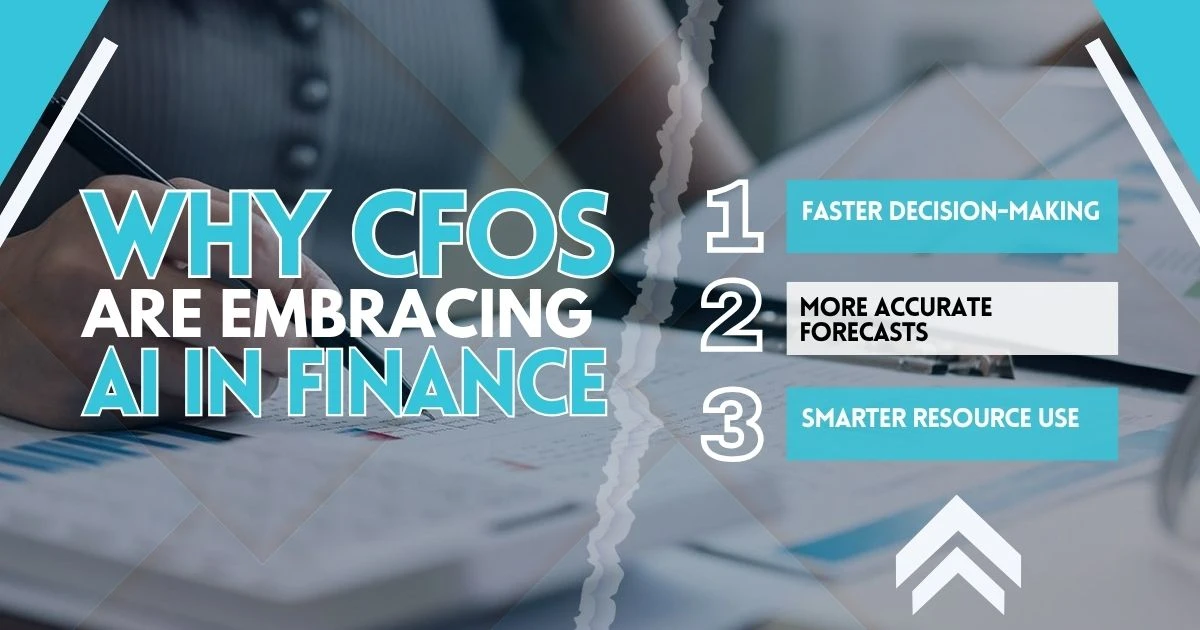FP&A stands for Financial Planning and Analysis. It’s how companies build budgets, create forecasts, track performance, and make big financial decisions. Traditional FP&A processes often involve a lot of spreadsheets, manual updates, and long hours. But AI is changing that.
AI FP&A tools bring speed, accuracy, and intelligence into the process. They automate repetitive work, help spot trends, and give finance teams insights they might miss on their own.
In short, they allow finance leaders to spend less time gathering data—and more time acting on it.
But what happens to companies that continue relying on outdated methods while their competitors advance with AI-powered insights?
Why CFOs Are Embracing AI in Finance

CFOs today don’t just want reports. They want real-time insights. They want to ask a question and get an answer—fast. They want to know where the business is going before it gets there.
AI makes this possible. Here’s why CFOs are making the shift:
- Faster Decision-Making – AI-powered platforms cut down the time it takes to build forecasts and reports—from days to minutes.
- More Accurate Forecasts – By analyzing historical data and current trends, AI can spot patterns and help teams plan more precisely.
- Smarter Resource Use – With less manual work, finance teams can focus on strategy, not just spreadsheets.
The Top AI FP&A Tools You Should Know About

Now let’s take a closer look at some of the leading tools on the market. Also, these platforms are helping CFOs lead with confidence—and make smarter decisions every day.
1. Pigment – The Modern Planning Powerhouse
Pigment is becoming more popular because of its clean look and easy-to-use design. It helps finance and business teams work together in real time, which makes planning smoother and faster.
This tool is best for medium to large companies that need flexible and team-driven planning. Also, some of its main features include real-time dashboards, scenario modeling, and forecasting with AI.
It also connects easily with tools like Salesforce, Google Sheets, and Workday. What makes Pigment stand out is its mix of powerful features and simple design, which makes it a favorite among teams that need to work together closely.
2. Planful – Speed Meets Scalability
Planful is built to help finance teams finish their reports faster and plan more effectively. It uses AI to make reporting, forecasting, and analysis easier and quicker. Also, planful is a great fit for growing businesses that want to scale their financial planning.
Its top features include continuous planning, machine learning insights, and automatic financial reports. Moreover, one of the reasons Planful stands out is that it offers high-level performance without being too hard to use, which is perfect for fast-moving finance teams.
3. Datarails – The Excel-Friendly Upgrade
Datarails is made for small to mid-sized companies that still use Excel every day but want to make their work smarter. It brings automation and AI into the spreadsheet tools teams already know.
Datarails helps with tasks like tracking changes, analyzing trends, and building reports, all with live data. Its best features include AI-powered analysis, smart budgeting, and automatic dashboards. That’s why Datarails is the go-to solution for teams that want to stay in Excel while modernizing their processes, automating workflows, and accessing real-time insights—without a full system overhaul.”
4. Cube – Planning Without Leaving Your Spreadsheets
Cube is another tool designed for people who work in Excel or Google Sheets. It helps teams do financial planning without needing to learn new software. Cube is easy to set up and use, which makes it great for small teams and fast-growing startups.
It allows real-time syncing with spreadsheets, quick launching, and secure access for team members. Also, cube is known for its plug-and-play style, which means teams can get started quickly and improve their planning process without changing everything.
Choosing the Right Tool: What to Consider

Selecting the right AI FP&A tool is an important decision for any finance team. There is no single solution that works for every business, so it’s important to consider your company’s unique needs and goals. Here are some key factors to help guide your decision:
1. Company Size and Growth Plans
The size of your company plays a big role in choosing the right tool. Smaller businesses or startups may benefit from lighter, more flexible tools that are simple to set up and easy to use. These tools can support basic budgeting and forecasting without adding too much complexity.
Conversely, larger companies often require more advanced features—such as detailed scenario planning, deeper data analysis, and stronger user controls.
2. Integration Needs
An FP&A tool should work smoothly with the software you already use. This includes your ERP (Enterprise Resource Planning) system, CRM (Customer Relationship Management), spreadsheets, and cloud data platforms.
The more easily a tool can connect with your current systems, the faster your team can start using it effectively. Because of seamless integration, your team can avoid manual work, prevent errors, and rely on more accurate, real-time data.
3. User Experience
Even the most powerful tool won’t help your team if it’s hard to use. A good FP&A platform should have a clean, intuitive interface and be easy to learn. Once usability is addressed, it should support collaboration by enabling team members across departments to work together, share insights, and make decisions based on a single source of truth.
Before making a decision, it’s essential to assess whether the platform offers comprehensive training or real-time guidance. Next, consider how this support facilitates faster onboarding, encourages confident usage, and ensures platform consistency. Ultimately, this leads to a more seamless rollout and long-term success.
4. Support and Onboarding
Reliable customer support can make a big difference—especially when you’re just getting started. Therefore, it’s important to look for a vendor that offers strong onboarding services, including training, setup assistance, and ongoing support. Moreover, having a responsive support team available when questions arise or issues occur is essential.
In fact, timely assistance helps your team stay productive, reduces downtime, and builds confidence as they adapt to the new tool. As a result, strong support should be a key factor in your selection process.
The Future of Finance Is Intelligent—But at What Cost?
AI FP&A tools promise speed, precision, and clarity in a world where every second—and every decision—counts. They’re not just replacing spreadsheets; they’re rewriting how finance operates. They’re the edge that separates reactive leadership from proactive strategy.
Yet beneath the dashboards and data models lies a deeper question: What kind of finance leaders are we building? As we give more power to machines, we must ask: will we lose the instinct and human touch that define great financial leadership? While technology improves decisions, it can’t replace empathy or intuition. Consequently, leadership must preserve what makes it truly effective. Meanwhile, the rise of AI in finance is unstoppable—and for many companies, essential. It sharpens forecasting, boosts productivity, and removes human error.
CFOs are no longer just keeping the books—they’re setting the direction.
FAQs
What is Financial Planning and Analysis (FP&A) and why is it important?
Additionally, Financial Planning and Analysis (FP&A) helps businesses manage budgets, forecasts, and performance to support smarter financial decisions.
How is AI used in FP&A processes today?
Moreover, AI in finance automates data gathering, provides real-time dashboards, and enhances accuracy through AI-powered forecasting and machine learning insights.
What’s the role of automation in FP&A tools?
Moreover, automation in FP&A reduces manual work by streamlining budgeting and forecasting, enabling finance teams to focus more on strategy.
How do tools with real-time dashboards and data modeling improve decision-making?
Additionally, they provide up-to-date insights and scenario analysis, helping teams react quickly to financial changes and plan more effectively.
